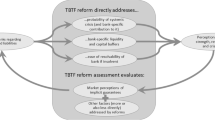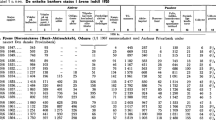Abstract
Using a synthetic control research design, we find that living will regulation increases a bank’s annual cost of capital by 22 bps, or 10% of total funding costs. This effect is stronger in banks measured as systemically important before the regulation’s announcement. We interpret our findings as a reduction in Too-Big-to-Fail subsidies. The effect size is large: multiplying our bank-specific point estimates by funding size implies a subsidy reduction of $42B annually. The impact on equity drives the main effect. The impact on deposits is statistically indistinguishable from zero, passing the placebo test for our empirical strategy.







Similar content being viewed by others
Notes
For empirical support of this political economy rationale, Brown and Dinċ (2011) show that after elections, policymakers are less likely to support failing banks.
Penas and Unal (2004) study bond financing cost effects of bank mergers. They find differentially large benefits when medium-sized banks merge to form a large bank.
Dam and Koetter (2012) use political instruments to show that German banks are more likely to enter distress if they expect a bailout, and Duchin and Sosyura (2014) use Troubled Asset Relief Program data to show that US banks originate riskier loans and shift assets toward riskier securities after getting bailed out.
If there was a strong effect of the policy decreasing the likelihood of default, it should be observable directly in a reduced price of credit default swap contracts. However, existing evidence does not corroborate a strong countervailing effect: Berndt et al. (2018) show a net increase in CDS prices for large banks in the years after Lehman Brothers’s failure, which the authors associate with a decrease in the perception of TBTF guarantees.
Note that since the outcome variables change between different tested outcomes, so too do the covariate weights and hence the synthetic control group weights.
The difference in size between banks subject or not to the new regulation remains an important challenge for this type of studies, due to the extreme skewness in the size distribution of US banks. For example, the average size of the ten smallest treated banks is about 90 billion, The average size of the ten largest of the non-treated is about 30 billion. This data characteristic advises against using traditional methods, and it is indeed one of the reasons we chose to adopt a synthetic control methodology.
While the two metrics are commonly used to gauge systemic risk, they nevertheless capture different factors contributing to overall risk. As highlighted in the literature, they may not yield similar rankings in a cross section of firms (Benoit et al. 2013). We present results using both to show that the result holds regardless of ones’ particular favored systemic risk measure, and is not sensitive to this choice.
Nevertheless, we ran a robustness test to gauge the potential impact of the regulation on the cost of new debt issuances. To do so, we gained access to the Mergent Corporate Bond Securities database and extracted information for all debt issues with an offering date between January 1, 2009 and December 30, 2016. We then hand-matched these issues to our main sample, yielding 22,199 issues mapped to our treated entities, and 115,636 mapped to other entities. We estimated a difference-in-differences model where the dependent variable was the spread over treasury (maturity matched) of each yield at issuance, against a dummy that turned equal to one for the announcement of the living wills policy, a dummy for the treated subset of issuers, and the interaction of the two dummies, while including time and parent company fixed effects. In the attempt to match treatment to a comparable control, we restricted the issuers in the control group to U.S. financial sector firms. We find that after the announcement of the living wills regulation, the banks subject to the treatment display relatively higher spreads. Interestingly, the point estimate of that effect, about 20 basis points, is of a magnitude comparable to our average synthetic control estimates for the non-deposit debt component (as reported on Fig. 6, right panel), which shows roughly a relative higher cost of debt for treated banks between 10 and 20 basis points. Consistent with our main analysis, both treated and untreated display a common negative trend, so this positive result indicates that treated banks experienced a relatively lesser decline.
References
Abadie A, Gardeazabal J (2003) The economic costs of conflict: a case study of the basque country. Am Econ Rev 93(1):113–132
Acharya VV, Anginer D, Warburton AJ (2016) The end of market discipline? investor expectations of implicit government guarantees. Technical report, Investor Expectations of Implicit Government Guarantees
Adrian T, Brunnermeier MK (2016) Covar. Amer Econ Rev 106 (7):1705–41
Athey S, Imbens GW (2017) The state of applied econometrics: Causality and policy evaluation. J Econ Perspect 31(2):3–32
Benoit S, Colletaz G, Hurlin C, Pérignon C (2013) A theoretical and empirical comparison of systemic risk measures. Technical report, HEC Paris Research Paper No. FIN-2014-1030
Berndt A, Duffie D, Zhu Y (2018) The decline of too big to fail. Technical report, Available at SSRN
Brown CO, Dinċ IS (2011) Too many to fail? evidence of regulatory forbearance when the banking sector is weak. Rev Financ Stud 24(4):1378–1405
Brownlees C, Engle RF (2016) Srisk: a conditional capital shortfall measure of systemic risk. Rev Financ Stud 30(1):48–79
Cavallo E, Galiani S, Noy I, Pantano J (2013) Catastrophic natural disasters and economic growth. Rev Econ Stat 95(5):1549–1561
Cetorelli N, McAndrews J, Traina J (2014) Evolution in bank complexity. Econ Policy Rev 20(2):85–106
Claus J, Thomas J (2001) Equity premia as low as three percent? evidence from analysts’ earnings forecasts for domestic and international stock markets. J Financ 56(5):1629–1666
Dam L, Koetter M (2012) Bank bailouts and moral hazard: Evidence from germany. Rev Financ Stud 25(8):2343–2380
Duchin R, Sosyura D (2014) Safer ratios, riskier portfolios: Banks’ response to government aid. J Financ Econ 113(1):1–28
Elton EJ (1999) Presidential address: expected return, realized return, and asset pricing tests. J Financ 54(4):1199–1220
Gandhi P, Lustig H (2015) Size anomalies in us bank stock returns. J Financ 70(2):733–768
Gandhi P, Lustig H, Plazzi A (2020) Equity is cheap for large financial institutions. The Review of Financial Studies 33(9):4231–4271
Gebhardt WR, Lee C, Swaminathan B (2001) Toward an implied cost of capital. J Account Res 39(1):135–176
Gropp R, Hakenes H, Schnabel I (2010) Competition, risk-shifting, and public bail-out policies. Rev Financ Stud 24(6):2084–2120
Hann RN, Ogneva M, Ozbas O (2013) Corporate diversification and the cost of capital. J Financ 68(5):1961–1999
Kelly B, Lustig H, Van Nieuwerburgh S (2016) Too-systemic-to-fail: What option markets imply about sector-wide government guarantees. Am Econ Rev 106(6):1278–1319
Kroszner R (2016) A review of bank funding cost differentials. J Financ Serv Res 49:151–174
Li Y, Ng DT, Swaminathan B (2013) Predicting market returns using aggregate implied cost of capital. J Financ Econ 110(2):419–436
O’Hara M, Shaw W (1990) Deposit insurance and wealth effects: the value of being too big to fail. J Financ 45(5):1587–1600
Pástor L, Sinha M, Swaminathan B (2008) Estimating the intertemporal risk–return tradeoff using the implied cost of capital. J Financ 63 (6):2859–2897
Penas MF, Unal H (2004) Gains in bank mergers: Evidence from the bond markets. J Financ Econ 74(1):149–179
Ueda K, Di Mauro BW (2013) Quantifying structural subsidy values for systemically important financial institutions. J Bank Financ 37 (10):3830–3842
Veronesi P, Zingales L (2010) Paulson’s gift. J Financi Econ 97 (3):339–368
Acknowledgements
The views expressed in this document are those of the authors and do not necessarily represent those of the Federal Reserve Bank of New York or the Federal Reserve System. We thank Anya Kleymenova for their comments and feedback. We also thank Michael Blank for providing excellent research assistance, and Maria Ogneva for sharing code. All errors are our own.
Author information
Authors and Affiliations
Corresponding author
Additional information
Publisher’s Note
Springer Nature remains neutral with regard to jurisdictional claims in published maps and institutional affiliations.
Rights and permissions
About this article
Cite this article
Cetorelli, N., Traina, J. Resolving “Too Big to Fail”. J Financ Serv Res 60, 1–23 (2021). https://doi.org/10.1007/s10693-021-00352-1
Received:
Revised:
Accepted:
Published:
Issue Date:
DOI: https://doi.org/10.1007/s10693-021-00352-1







